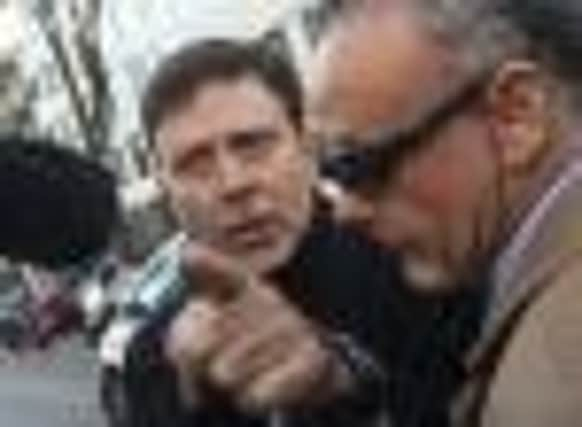Tom English: Fuentes dope case could rock football


Munoz is director general of the Spanish Anti-Doping Agency, Santamaria is the judge in the trial of Eufemiano Fuentes, one of cycling’s most notorious doping doctors, who stands accused of offences against public health. In the past months, some of Fuentes’ clients from the cycling world have given evidence about the products that he gave them, most notably blood transfusions. In 2006, as part of Operation Puerto, Spanish police raided Fuentes’ premises and seized anabolic steroids, transfusion equipment and 200 refrigerated bags of blood. That was the starting point. On Tuesday, the trial is set to conclude.
Last week, Munoz had some interesting things to say. “On the day the trial ends, me personally, I will go and ask the judge to give me all the documents as well as all the blood bags,” she said. “Then we will undertake every action to find and identify the athletes and sports involved in the Fuentes case.”
Advertisement
Hide AdAdvertisement
Hide AdMunoz knows, as everybody knows, that Fuentes’ client list contained more than just cyclists, although it was only his work with bike riders that was allowed to be discussed in the court case. He had upwards of 200 athletes on his books and only 50-60 of them were cyclists. The rest are believed to be from other sports including tennis and football. Fuentes himself has confirmed that footballers visited him at his clinic, although he has stated his work with them did not involve doping. Munoz would like to know more about that.
She will ask for Santamaria to lift her ban on naming Fuentes’ other clients. If the judge agrees then we will get to see inside his world and who, exactly, lived in it with him: not just the bike riders, but everyone. Fuentes has said that he will name names if he is formally requested to do so.
“If they felt I was useful and they asked me, I would consider it and would be willing,” he said. “What I don’t know is if what I would give them would be worthwhile to them or not.”
Worthwhile? Many would say that seeing his full client list and hearing him talk about his association with other athletes is not only worthwhile but critical. There have been so many allegations made in recent times that the truth needs to come out.
Last September, Jesus Manzano, the former professional cyclist and client of Fuentes, said that he had seen “well-known footballers” at the doping doctor’s clinic.
We don’t know who they were and why they were there, but the time to find this out is long overdue.
A few years back, Fuentes did indeed talk about his links with football, but he did so in an enigmatic way, answering but not answering, just adding more mystery as he went. Asked which clubs his footballing clients belonged to, he replied: “I can’t tell, I have received death threats. I was told that, if I told certain things, my family and myself could have serious problems. I’ve been threatened three times and it’s not going to happen a fourth time. There are sports against which you cannot go against, because they have access to very powerful legal means to defend themselves.”
These comments demand exploration. These and others. Jorg Jaksche, another professional cyclist who gave evidence in Fuentes’ trial, has in the past described Fuentes as a “doping genius”. Jaksche said that Fuentes would offer blood transfusions for £3,400 at time and that the doctor once told him that he worked with “top soccer teams”. Over the past few years Fuentes has hinted about who those teams were, only to row back when pressed for more information.
Advertisement
Hide AdAdvertisement
Hide AdInaki Badiola wasn’t so mysterious. Badiola is a former president of Real Sociedad and in an interview with the AS newspaper in early February he stated that performance-enhancing drugs were administered to players at the club in a regime previous to his own. The person who oversaw the doping programme, he revealed, was Eufemiano Fuentes. Badiola said that he discovered annual payments to Fuentes of almost ¤328,000 in the early years of the new millennium. One of the regimes that Badiola referred to was that of former president Jose Luis Astiazaran, who is now president of the body that governs La Liga. Astiazaran completely denied Badiola’s accusations.
Badiola sacked club doctors, Eduardo Escobar and Antxon Gorrotxategi, when he made his discovery. “They acquired substances which were not authorised,” said Badiola. “What is certain is that, in 2008, our board publicly denounced doctors Eduardo Escobar and Antxon Gorrotxategi because, in the six seasons before us, at least, the directors paid for medicines or products which at that moment were categorised as used in doping. These were acquired with dirty money on the black market.”
Spanish football did not want to hear what Badiola had to say, a succession of people seeking to bury him. Angel Maria Villar, the president of the Spanish FA, said categorically that there is no doping in the game in Spain, saying that everything else is just “talk, talk, talk...”
Vicente del Bosque, manager of the national team, was equally certain of football’s innocence, despite numerous cases in Spain of players testing positive for doping products and then being banned.
What does Fuentes know? Which footballers did he treat and what did he give them? Munoz will ask these questions. The hope for football – and tennis and the rest – is that Santamaria will give her the client list and that Fuentes will explain what he did and who he did it for.